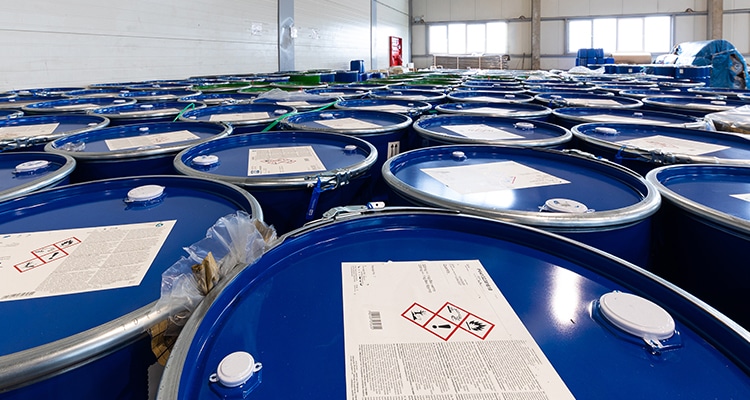Know the L-TRIC
How is it determined if the waste from a facility process is a hazardous waste? Hazardous waste is regulated by the United States Environmental Protection Agency (EPA). Companies must determine if they have hazardous wastes at their facility. Hazardous waste regulations can be difficult to navigate, as the regulations establish a complex definition, but there are a few “tricks” you can use to remember the steps to determine if the waste meets the hazardous waste definition. The acronym L-TRIC is an easy way to remember the criteria for hazardous waste determination where the “L” represents Listed wastes, “T” represents Toxic, “R” represents Reactive, “I” represents Ignitable, and “C” represents Corrosive. But deciding if the waste is listed or has a characteristic of hazardous waste is just a piece of the puzzle. That is why the EPA provides a resource for the Introduction to Hazardous Waste Identification that gives a regulatory overview of the process with references to the regulations.
The Resource Conservation and Recovery Act (RCRA) regulation at 40 CFR 262.11 is the key reference for hazardous waste determination. The regulation leads the reader through the four steps in the identification process. It directs the reader through a series of questions: Is the waste a solid waste? Is the waste excluded? And finally, is the waste listed as a hazardous waste or does it exhibit a hazardous waste characteristic?
The Definition of a “Solid Waste”
Of course, for any material to meet the definition of hazardous waste, it must first be a waste. Nearly everything we do leaves behind some kind of waste. Using the EPA’s definition of a solid waste, which spans several paragraphs and has more references than can be listed here, it must be determined that the waste is discarded material that is not excluded by other regulations and material which is abandoned, recycled, or considered inherently waste-like. Also, a solid waste does not have to be physically solid, although it may be. Solid waste can be semi-solid, liquid or even gaseous material. Once it is determined that the waste in fact is a solid waste, the next step in the determination process, which is to determine if the waste is a listed or characteristic hazardous waste, can be taken. Thankfully, the EPA has produced a hazardous waste identification flow chart to aid in this determination process.
Listed Hazardous Waste
Any waste fitting a narrative listing description of a specific type of waste is considered hazardous, regardless of its chemical composition or any other variable, is called a listed hazardous waste. The benefit of a listed waste is the originator only needs to know the wastes’ origin to determine if it is hazardous. Whereas with characteristic waste, laboratory analysis may be necessary.
Characteristic Hazardous Waste
The hazardous waste characteristics are the chemical properties that make a waste dangerous to human health or the environment and therefore hazardous. These characteristics provide a more complete and inclusive means of identifying hazardous wastes than do the hazardous waste listings. The EPA decided that generators must be provided with “widely available and uncomplicated test methods” for determining if wastes exhibited hazardous characteristics. The four characteristics of hazardous waste are:
- Toxic – Toxicity is determined by a lab procedure is known as the Toxicity Characteristic Leaching Procedure (TCLP). If a sample of waste contains any of 39 different toxic chemicals above specified regulatory levels, then the waste exhibits the toxicity characteristic.
- Reactive – A reactive waste is one that readily explodes or undergoes violent reactions. Reactivity is defined through determining if the waste has any reactive properties found in 40 CFR 261.23.
- Ignitable – Ignitable wastes are wastes that can readily catch fire and sustain combustion. The definition includes liquid and solid wastes in 40 CFR 261.21.
- Corrosive – Corrosive wastes are acidic or alkaline (basic) wastes which can readily corrode or dissolve flesh, metal, or other materials. The full definition explaining how the EPA uses two criteria to identify corrosivity can be found at 40 CFR 261.22.
Additional Rules and Policy
Since hazardous waste can be a mixture of many different chemicals, it is important to look at the characteristics of the waste individually as well as together as a compound and take into account the “mixture” and “derived-from” rules, the “contained-in” policy and the Hazardous Waste Identification Rules (HWIR) which was the EPA’s attempt to “increase flexibility to the hazardous waste identification system”. And remember, state regulatory requirements for generators may be more stringent than federal requirements, so be sure to check specific state policies.
The process of determining whether or not the substance poses enough of a chemical or physical hazard to meet the definition of a hazardous waste is anything but simple. Developing a comprehensive program that ensures safe handling of all wastes, but especially the determination of whether any material is hazardous according to RCRA, is critical to the health and safety of workers and the environment. At Chemical Safety, we understand the complexities of hazardous waste generation and determination. Our comprehensive EMS software has all the features needed to manage hazardous waste from generation and determination to final disposition. The good news is that there is an abundance of modules, guidance documents and resources at the EPA’s Hazards Waste website and the professionals at Chemical Safety are ready to help you understand how technology can assist in developing a comprehensive hazardous waste management program.
Reference: RCRA Training Module- Introduction to Hazardous Waste Identification
Chemical Safety offers a comprehensive suite of EH&S software applications, including GHS Labeling, Safety Data Sheets, chemical inventory tracking, hazardous waste management, environmental regulatory reporting, employee workplace safety & compliance.
Request a demo to learn more about how Chemical Safety’s Environmental Management Systems (EMS) software can help overcome many of the EHS challenges unique to your industry.



